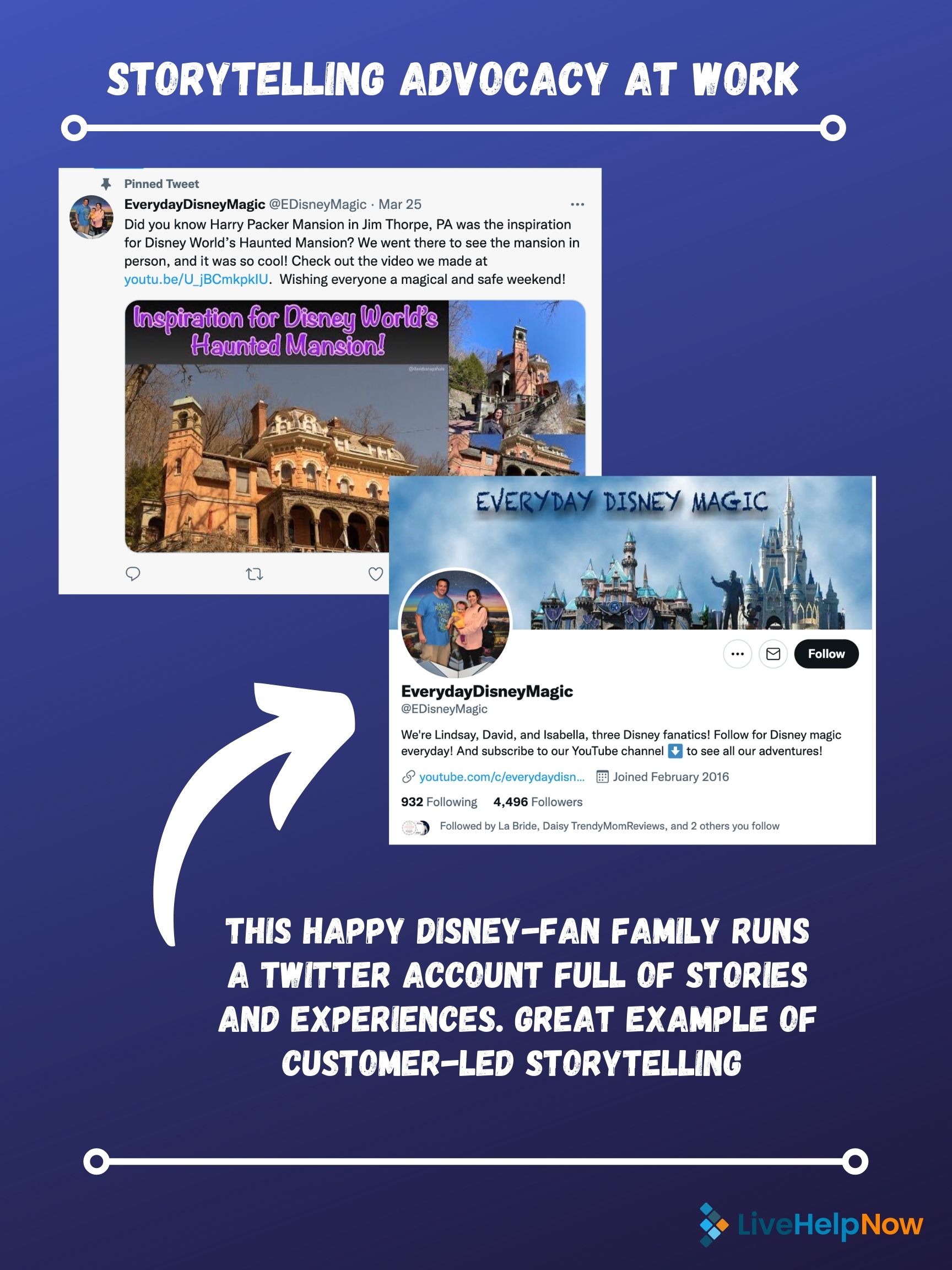Meet Janet. Janet lived in a different state but wanted to send some sympathy flowers to a friend in Pennsylvania. After reading some reviews she found a flower shop near her friend’s house that not only had good reviews but was also open on Sunday. It also offered same-day delivery. Janet placed an order and was so satisfied with everything, she wrote a review for the flower shop. Here is what it said:
“The arrangement was “stunningly beautiful.” I will be sharing on my Facebook page as I still have many friends in Philly that most certainly need to use this florist! I am an EXTREMELY satisfied customer and most certainly will be using them in the future!”

Image Courtesy of NE Flower Boutique
Janet is a perfect (and happy) example of a brand advocate. There is no better advertising than word of mouth from satisfied customers. And if they have a story to go along with their loyalty, that’s priceless. When a customer is so happy with a brand, she proactively talks about it.
Why Do Businesses Need Brand Advocates?
Dr. Deborah Goldring, an Associate Professor of Marketing at Stetson University explains why brand advocates are so valuable to businesses.
“Brand advocates engage in an evolved form of positive word of mouth that results from deeply held, enduring emotions toward a brand,” she says. “Brand advocates willingly spend their time and effort engaging in positive storytelling about a brand on social media, online brand communities, and product review sites. They strongly recommend it to others and will even defend a brand when it is attacked by negative publicity or competition.”
Such advocacy is extremely valuable to companies. As studies show, social media users trust their connections most for product advice.
“Consumers say they are most likely to take product recommendations from an everyday user (37%) over those of subject matter experts (25%), celebrities (7%), social media stars (6%), or even a brand’s own social media account (8%). (Marketing Charts)
Sharing Stems From Caring
People make decisions based on their emotions. Then, they justify this decision with logic. Harvard Business School professor Gerald Zaltman attributes 95 percent of decision-making to the subconscious mind. It is, therefore, important to appeal to customers’ emotions during their experiences with a brand.
Taking a look at various psychological principles can help companies optimize their customer experiences to appeal to customers’ emotions. Some things are universal to all humans – like the need to feel respected, the desire to fulfill our goals, and the ability to filter out relevant information. Relying on these psychological principles to in general enhance customer experiences is a solid strategy.
Let’s go a step further, however, and to appeal to customers’ emotions on a level that prompts them to actively advocate for the brand. This requires a closer look at the Principle of Reciprocity.
If someone sends someone a gift, the recipient’s natural reaction is likely to reciprocate. The Law of Reciprocity describes the universal tendency in human beings to reciprocate to an act of generosity or kindness. If someone is nice to us, we want to be nice back. The application of this principle creates miracles in the customer service world.
Think of an instance when a company representative went out of the way for you. It could be something small, like a restaurant server complementing your outfit or writing a funny joke on your to-go bag. Or it could be something bigger like a realtor driving an extra hour in a rainstorm to show you a property. Either way, when someone goes above and beyond for a customer, the customer’s natural reaction is to tell the story. That is how customers turn into brand storytelling advocates.
Strategies That Enhance Customer-Led Storytelling
When it comes to storytelling, Henry DeVries, author of Persuade with A Story! knows what he’s talking about. After all, he made persuasive storytelling his career. In his writing and speaking, he often discusses pragmatic strategies that can produce desirable results.
“Before I learned about storytelling psychology, I struggled to find enough clients. As a business owner, company president, and independent consultant, the wolf was always at my door,” he says. “Now I have helped thousands learn the secrets of business development through storytelling.”
DeVries uses Hollywood movie productions as an example of effective storytelling. He believes applying the same tactics in business can do great things for customer-led brand advocacy.
“Hollywood is the emotion picture capital of the world,” DeVries says. “Hollywood knows how stories tap into our emotions through psychological strategies. If you want to have more impact and influence, you need to learn and use three psychological storytelling strategies.”
Strategy #1: Discover One of the 8 Stories.
DeVries, as well as other academics who study storytelling, say that there are only 8 types of “stories” that humans are psychologically wired to respond to.
They are:
- The monster problem story
- The underdog story (a.k.a. Rags to Riches)
- The comedy solution
- The tragedy solution
- The mystery
- The quest
- The rebirth
- The escape (a.k.a. Voyage and Return)
Determining which of these stories best fits the customer’s journey is the first step on the way to connecting to customers.
It’s sometimes hard to pinpoint and figure out which one of these best fits your customer’s journey. One of the best tactics to help you with that is to create a customer journey map, here is how HubSpot defines it:
A customer journey map is a visual representation of the process a customer or prospect goes through to achieve a goal with your company. The goal may be making a purchase, signing up for a newsletter, joining a loyalty program, or anything in between. With the help of a customer journey map, you’ll get a better understanding of what will motivate your customers to achieve these goals.
This may seem like a lot of work but don’t worry, there are a ton of different tools and templates out there to help you create a nice and easy visualization. If you’re looking for a tool Preceden recently published a great review of the top 38 timeline software tools which is a great place to start.
Strategy #2. Use the Easy 1-2-3 Formula.
Next, a brand must determine which characters the brand, the customer, and the product play in the story.
“The human brain is hardwired for a series of three. In storytelling, there are represented by the hero, nemesis, and mentor. Think Luke, Darth, and Yoda from Star Wars. These should be the characters in your stories as well.” DeVries says.
Strategy # 3. Problem-To-Solution Stories.
Customer experiences with a product are (or should be) problem-to-solution stories. Sometimes the company plays the role of a hero by having their customer support staff use helpdesk software or other tools to take their customers from mess to success. Other times, a company or a product serves as a sidekick when it does some important behind-the-scenes work to help the hero reach his or her goal.
“You have a hidden asset that will set you apart, something nobody else can offer: your defining stories. Your hero stories can communicate your trustworthiness in two minutes or less,” DeVries says.
Practical Applications
What do these strategies mean for brands who are trying to connect to customers?
It means that when companies create customer experiences they should keep these themes and storytelling elements in mind. Which of the story types best fit the customer? What characters are customers playing in these stories? What roles do the brand and its products or services play in the story? Knowing the answers to these questions can help shape the story and draw it to a natural (and happy) conclusion. Close examination of the buyer’s journey can help companies understand their customers and their stories better.
With the psychological hardwiring in place, customers will connect to these stories. Then, they will be more likely to share them in their social circles. At the same time, a brand looking to tell a customers’ story on its own can also do so, connecting to its audiences and making more connections with potential clients.
Here Are Some Examples of Brand Advocates at Work
One very vivid – and quite magical – example of storytelling as part of customer experience is none other than Disney. The company lives and breathes customer experience excellently and treats every customer with exceptional care. The company has developed a concept called Guestology. What it is an understanding of customers on a deep level. Guestology combines demographic data and information about customers’ needs, wants, preconceived notions, and emotions. Guestology helps businesses identify and commit to a shared purpose. For Disney, this purpose is to create happiness through customer experience.
The company creates stories in accordance with the three strategies we discussed earlier not only through its characters but through every aspect of the customer experience. This prompts Disney’s customers to reciprocate by telling these stories, themselves becoming the brand’s active advocates.
Check out this Tweet, shared by true Disney storytelling advocates.

To influence customer experience and shape the customer’s story, companies must apply the very best practices of customer experience. From innovative service practices to specific employee engagement tactics, creating story-worthy experiences will translate into story-telling customers.
How to Encourage Advocating Reviews
Of course, when customers tell the stories of their experiences with your brand, they do so on their own accord. It doesn’t hurt, however, to encourage customers to write reviews and do so in a way that appeals to wider audiences and attracts new business.
Ken Kerry, the CEO and Executive Creative Director at Script to Screen recommends asking customers to specifically address three points to produce effective and advocative reviews:
- Suggest to customers to write about why they decided to buy your product or service and how it answered their pain point.
- Ask satisfied users to comment on how the product or service helped them.
- What is the outcome? Tell happy customers to discuss how great their business or personal outcome was, following the use of your product or service.
Turn Your Customers into Your Brand Advocates By Employees Storytelling Strategies
Did you notice how I started this article with a story of a florist and her happy customer? I would hope that it attracted your attention. Stories tend to do that. That is why it’s so beneficial for companies to embrace the art and the science of storytelling. Employing psychological storytelling strategies and tactics when engaging with customers can help brands relate to their audiences through better customer experiences. It can also encourage customers to share their stories, write reviews, and, essentially, attract new customers.




